#seitanic
Text

[ID: A greyish brown stew presented alongside flatbread, red pepper paste, green peppers, and carrot sticks. End ID]
سماقية / Summagiyya (Gazan stew with chard, chickpea, sumac, and 'lamb')
Summagiyya (سُمَّاقِيَّة; also translitered "sumagiyya", "sumaghiyyeh" or "sumaqiyya") is one of the signature dishes of the Gaza strip, in particular Gaza City. It consists of lamb, chard, and chickpeas in a sumac-infused broth; savor and zest is added by a dagga of dill seeds, garlic, and peppers, and nutty depth by a generous drizzle of red tahina. The resulting stew is thick, earthy, and slodgily grey (due to the green chard and red sumac)—it also has the characteristic sourness of much Gazan cuisine.
Summagiyya is most often prepared during holidays, especially Eid al-Fitr; it's an excellent make-ahead dish for these occasions, since it's even better once its flavors have had time to meld and mellow overnight. It is served cold alongside fresh vegetables, and eaten by using flatbread to scoop up each bite. This recipe provides a spiced seitan recipe to replace the lamb, but you may also use any lamb or beef substitute of your choice.
Today, summagiyya is often prepared with Israeli white tahina, as decades of punitive import laws, taxes, and restrictions have enforced Palestine's status as a consumer, rather than an producer, of food products. Israeli tariffs on, and confiscations of, Palestinian goods have forced those tahina factories that survived to import sesame seeds rather than using locally grown crops, even as they export the best of their product to Israel. The dubbing of foods such as tahina and hummus as culturally "Israeli" cuisine works to hide this exploitative relationship, and cement an Israeli national identity through the subsuming and erasure of Palestinian existence. It is for this reason that Emad Moussa writes that Palestinian cuisine has a role in "protecting against a people's very extinction."
Medical Aid for Palestinians (MAP) has put out an urgent call for donations to provide medical supplies to Palestinian hospitals when supply lines reopen. Also contact your representatives in the USA, UK, and Canada.
Ingredients:
For the soup:
500g (2 large bunches) chard (شلق), diced
80g Levantine sumac berries (Rhus coriaria)
1/2 cup soaked and boiled chickpeas, mostly cooked (40g dry / scant 1/4 cup)
1/4 cup red tahina
1/2 cup (60g) all-purpose flour
1 large yellow onion
1/4 cup olive oil
1 tsp kosher salt
2 cardamom pods (optional)
2 allspice berries (optional)
More olive oil, to fry
Sumac berries can be found in the spice section of a halal grocery store. If you're unable to locate whole berries, pre-ground will do.
For the dagga:
1 1/2 Tbsp dill seeds
5 cloves garlic
1/2 green cubanelle pepper
2-3 dried red chilis (optional)
1/2 tsp black pepper
1/4 tsp cumin
Dill seeds may be found at a halal, south Asian, or speciality European grocery store. They are commonly used in Indian food and as a pickling spice. At a south Asian grocery store they may be labelled soyo, suva, shepu, or savaa.
For the lamb:
1 cup (120g) vital wheat gluten, aka gluten flour
1/2 Tbsp ground sumac
1/2 tsp ground caraway
1 tsp onion powder
1 tsp Palestinian 7-spice
1/2 tsp garlic powder
1/2 tsp sea salt
1/2 tsp ground black pepper
1/2 tsp ground cumin
1/2 tsp ground aniseed
1/2 tsp turnermic
1 tbsp olive oil
1/2 tsp soy sauce
1 tsp miso paste
2 cloves garlic, grated
2 tsp pomegranate molasses
1 Tbsp white or red tahina
About 1/2 cup vegetarian 'beef' stock from concentrate, or vegetable stock
Pomegranate molasses is simply pomegranate juice that has been reduced to a thick consistency. It may be found in the sauces section of a halal grocery store.
Instructions:
For the soup:
1. Soak dried chickpeas in cool water overnight, or in just-boiled water for an hour. Drain and re-cover with water, and boil for 30-45 minutes, until almost fully cooked. Drain and set aside.
2. Simmer sumac seeds in enough water to cover by a couple inches for about an hour, until the water is dark red. Blend the seeds and water together, then strain the mixture through a cheesecloth.
If you're using ground sumac, skip the blending step. Use a cheesecloth or very fine metal sieve (such as one intended for brewing tea) to remove the ground spice from the water.
3. Whisk the flour into the sumac-infused water.
For the lamb:
1. Combine all dry ingredients in a large mixing bowl. Add wet ingredients other than stock and stir briefly. Add enough stock to produce a soft, smooth dough.
2. Knead by hand on a clean surface, or put in a stand mixer with paddle attachment on medium-low, for about 5 minutes. You should see stringy strands begin to form in the dough.
3. Allow to rest, covered, for 5-10 minutes to encourage gluten formation. Knead for another 3 minutes. Do not over-knead.
4. Tear the dough into bite-sized pieces.
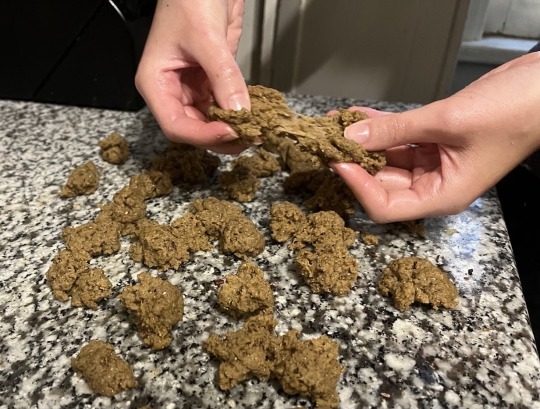
Stringy seitan being pulled apart into pieces.
You may also shape the dough into a slab and cube it with a sharp knife—the lamb or beef used in summagiyya is usually cubed—but I prefer the texture of torn seitan to sliced.
5. Steam the seitan pieces for 10 minutes in a bamboo steamer or using a metal steamer basket. Place the bamboo steamer in the bottom of a wok and cover its base by about 1/2" (1 cm), then raise the heat to boil the water; lower the heat to keep the water at a simmer. If using a steamer basket, place it over the opening of a pot containing a couple inches of water and bring it to a simmer. Start the timer when the water begins simmering.
6. Heat olive oil on medium-high and sear the steamed seitan pieces, turning as necessary, until deeply browned on all sides. Set aside.

Fried seitan pieces.
You can save a step here by searing the raw seitan, then returning it to the pot after you've fried the onions to simmer it rather than steaming. I found that this produced a mushier texture.
For the dagga (دقة):
1. Grind cumin and black pepper thoroughly in a mortar and pestle, then add dried red pepper and dill seed and crush coarsely. Add green sweet pepper and garlic and pound until a coarse mixture forms.
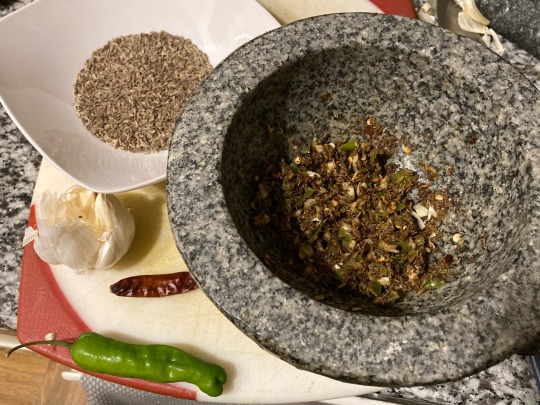
Dill seeds, green sweet pepper, garlic, and dried red chili on a cutting board, alongside dagga in a large granite mortar.
You may also use a spice mill or food processor.
To assemble:
1. Chop the onion. Wash the chard and slice it thinly in one direction; turn it ninety degrees and slice thinly again.
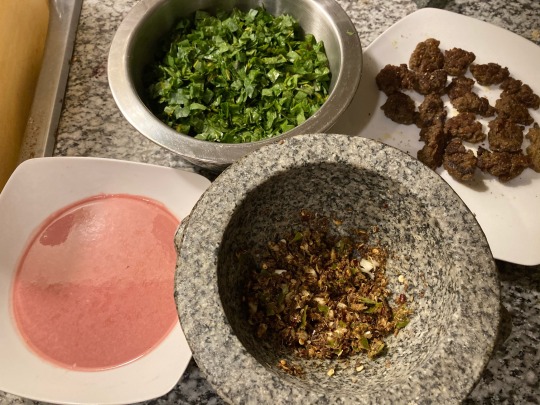
Diced chard, fried seitan, dagga, and sumac-infused water with flour.
2. In a large pot, heat a couple tablespoons of olive oil on medium. Fry chopped onion, cardamom pods, and allspice berries for a minute until fragrant. Add half of the dagga and fry until fragrant.
3. Add chard and fry, mixing often, until wilted.
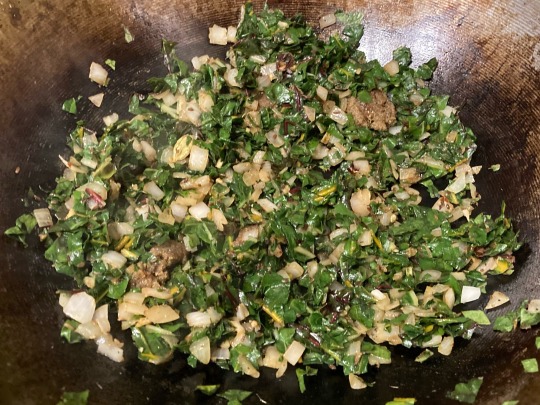
Wilted chard in a wok.
4. Add sumac mixture, chickpeas, and water to cover. Bring to a boil, then lower heat to a simmer. If you didn't steam your seitan earlier, add it now.
5. Continue to stir and simmer until the stew is thick, homogenous, and greyish-brown, about 15 minutes.

Simmered stew.
6. Add the remainder of the garlic mixture, the red tahina, a pinch of ground cumin, the 1/4 cup olive oil, and salt to taste. Return the steamed and seared seitan to the pot and mix.
Serve cool with flatbread, sweet green peppers, bitter green and black olives, carrots, leafy greens, and/or pickles.
#vegetarian recipes#vegan recipe#vegan cooking#Palestinian#Gazan#chickpeas#lamb#seitan#chard#dill seeds#pomegranate molasses
488 notes
·
View notes
Text

Tacos Vegan aux Émincés de « Poulet » et Sauce Ranch / Vegan Spicy « Chicken » Tacos and Cilantro Ranch
#vegan#lunch#tacos#tortillas#vegan chicken#seitan#mushrooms#onion#garlic#lettuce#vegan cheese#oregano#cumin#paprika#chili#cilantro#vegan yogurt#lime#olive oil#black pepper#sea salt
69 notes
·
View notes
Text
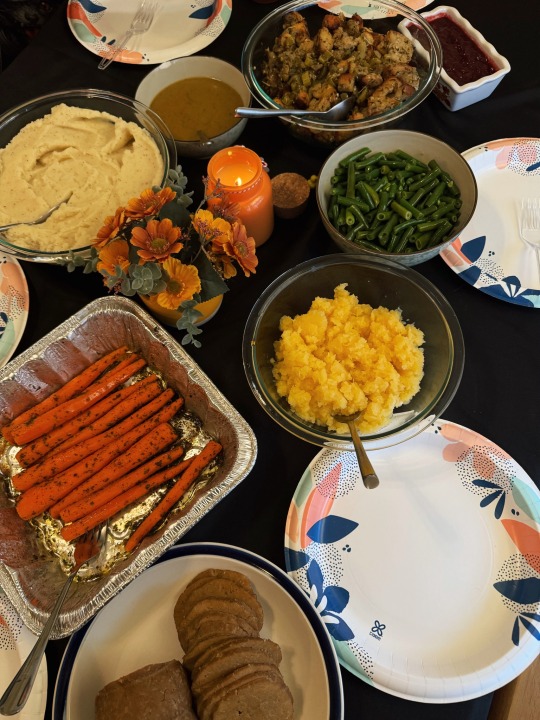


I know thanksgiving is a shit holiday but sitting at a table listening to good music while eating a big vegan meal with people who love you is 🧡
#vegan#vegetarian#food#mine#vegan thanksgiving#thanksgiving#seitan#I miss doing the submit your thanksgiving meal pics#I’ll do it next year
340 notes
·
View notes
Text

Seitan limani, Crete, Greece
#photography#greece#colorful#nature#landscapephotograpy#nofilter#greekislands#aegean sea#crete#Seitan limani#hiking
37 notes
·
View notes
Photo

Seitan Limania beach, Greece 🌊 Photo: @george_galanakis_photography for allincrete on Instagram.
301 notes
·
View notes
Text
Vegan Seitan Steaks
#vegan#food#vegetarian#vegan food#veganism#recipe#plantbased#dinner#vegan recipe#vegan steak#vegan meat#meatless#meat replacement#seitan
92 notes
·
View notes
Text
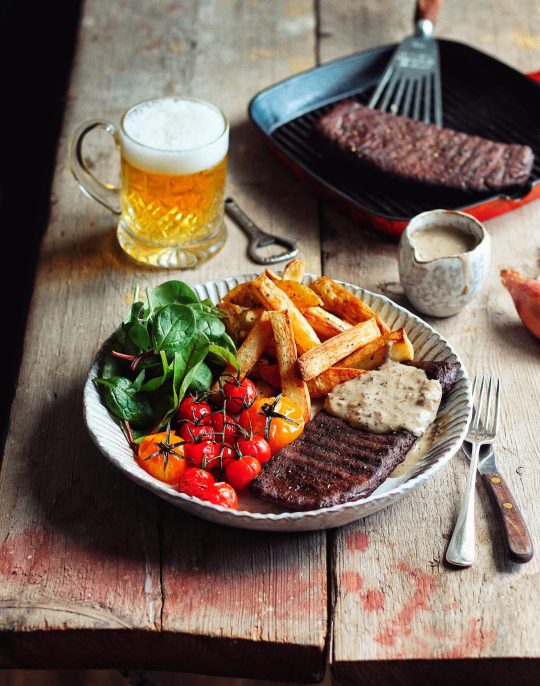
Vegan Steak & Peppercorn Sauce Recipe
#beef#steak#dinner#lunch#savoury#seitan#peppercorn#beef steak#vegan#veganism#vegetarian#recipe#recipes#food#fries#pub food#avantgardevegan#beer
24 notes
·
View notes
Text

Seitan Limania Beach, Greece
#seitan limania#beach#beachlife#beaches#greece#europe#travel photography#amazing nature#nature#travel#travel destinations#sea
30 notes
·
View notes
Text

잼파이어치킨 (Vampire Chicken) / Seoul, South Korea
Green onion and mustard seitan “chicken” 🍗
#vegan#veganism#what vegans eat#vegan food#vegan eats#vegan travel#vegan friendly#Seoul#South Korea#gangnam#서울#비간#vegan Seoul#chicken#fried chicken#vegan fried chicken#vegan chicken#seitan#hail seitan#travel#travel food#travel blog#travel diary
22 notes
·
View notes
Text
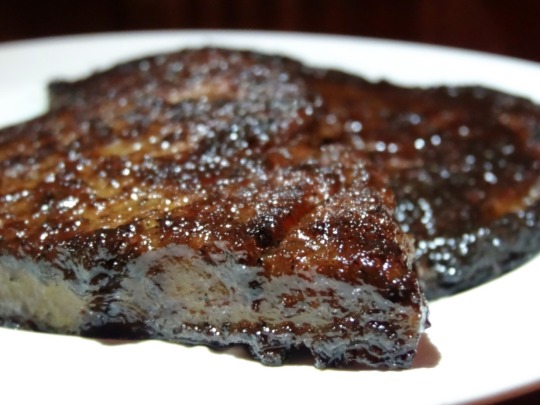
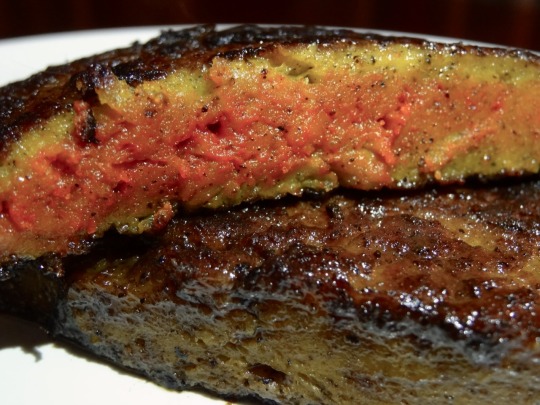
[ID: First image is of two dark brown glazed lamb chops. Second image is a close-up; one of the chops has been cup open to show a pink interior. End ID]
Seitan lamb chops
This vegan meat can be used as a substitute for lamb chops or rack of lamb. Like well-cooked lamb, it is fine-grained, moist, subtly sweet, and meltingly tender. Once simmered it is ready to be seared, breaded, fried, or sliced, and included in your favorite recipes.
The seitan is made using the washed flour method, which kneads dough in water to separate the gluten from the starch: this allows you to control how much starch you leave alongside the gluten in the dough, and thus how tender versus chewy your final cut of meat will be. This recipe makes a dough that leaves more starch in than most seitan recipes do, and then kneads the dough again to distribute that starch into an even, fine grain. A simmer in a spiced, aromatic broth leaves the final product tender, moist, and flavorful all the way through; the broth is then cooked down to a glaze.
The spices called for in this recipe are geared towards replacing lamb in Palestinian recipes, but they can easily be swapped out to complement the flavor profiles of other dishes.
Recipe under the cut!
Patreon | Tip jar
Makes 4 large lamb chops.
Ingredients:
For the dough:
720g bread flour (or any white wheat flour with at least 12% gluten)
About 2 1/4 cups water
For the dry flavoring mix (scaled to 455g dough yield):
2 tsp (7.5g) ground sumac
1 3/4 tsp (5.25g) onion powder
1 tsp (4g) kosher salt (1/2 tsp table salt)
1 tsp (5.5g) vegetarian granulated sugar
1 tsp (2.5g) black peppercorns, toasted and ground
3/4 tsp (2g) caraway seeds, toasted and ground
3/4 tsp (3g) garlic powder
3/4 tsp (2.5g) ground turmeric
3/4 tsp (2g) cumin seeds, toasted and ground
3/4 tsp (1.5g) aniseed, toasted and ground
1/2 tsp beet powder; or 5 drops red + 1 drop green food coloring
1/2 tsp (2.5g) MSG (optional)
To fry:
4 tsp vegan margarine or ghee (سمنة), divided
4 tsp olive oil, divided
For the simmering broth:
2 Tbsp soy sauce (I used Chinese aged soy sauce)
1 Tbsp red tahina
2 tsp miso paste (preferably red)
2 tsp pomegranate molasses
2 tsp vegetarian 'beef' stock concentrate (optional)
1 small yellow onion, quartered
2 cloves garlic, crushed
1 bay laurel leaf
1 stick cinnamon bark
5 allspice berries
5 green cardamom pods, crushed
2 cloves
1/2 tsp black peppercorns
1 tsp vegetarian granulated sugar
Several cups water
Instructions:
To wash the flour:
To make seitan using the washed flour method, a dough is first made out of flour and water; then, the dough is washed in water multiple times. The water carries off the starch, leaving the gluten behind.
1. Make the dough. Mix flour and water in a large mixing bowl until dough comes together. Knead for several minutes, and then cover the dough and allow it to rest for another 10-15 minutes to develop gluten. After resting, the dough should be very smooth, elastic, and stretchy.

2. Soak the dough. Fill the bowl with enough cool water to cover the dough, and let it soak for about an hour. This allows gluten to continue developing.
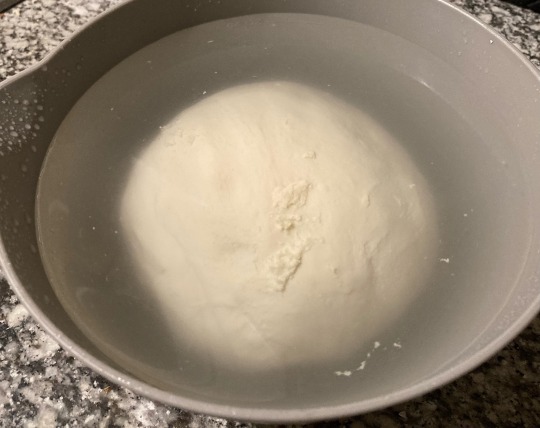
3. First wash. Leave the soaking water in the bowl, and begin to knead the dough with your hands under the water. Repeatedly pull, stretch, fold, and press the dough for several minutes to knead, occasionally using your fingertips to break through and shred or mangle the dough as you pull. Soon, the water should be a thick, opaque white.
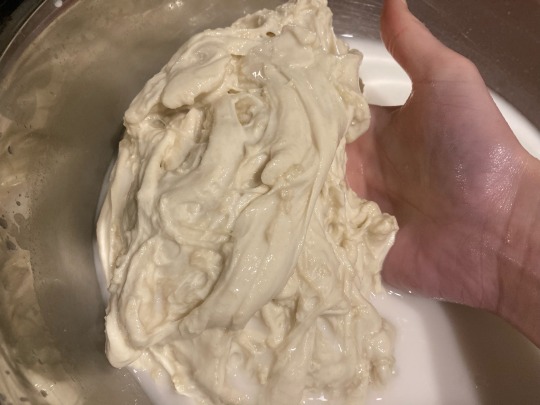
4. Drain the dough. Set up a colander over a very large container, and pour the contents of your mixing bowl through. You can also just pour the starchy water down the sink if you don't have plans to use it (to make liangpi noodles, or dumpling wrappers, or any of the recipes out there for vegan bacon using wheat starch...).
At this point, you will see two distinct substances in the dough: the gluten, which is thin and stringy and feels rubbery when pinched, and the starch, which is thick and 'globby' and feels soft when pinched, offering no resistance. We want to wash the flour a few times until most of the starch has been removed, and there are only some small globules interspersed throughout the stringy gluten.
5. Second wash. Return the dough to your mixing bowl and fill it with fresh cool water. Knead and pull the dough for another few minutes, until the water once more turns opaque. There should be fewer large areas of starch in the dough, and more development of the gluten strands. Drain the dough again (just like in step 4).

6. Third and fourth wash. Repeat this process another time or two, until the starch globules are about 20% of what you see, and the gluten is around 80%. For the last wash, the water should be a bit less opaque with starch than it was for the first one, but it should be more than a bit cloudy. You should see your fingers when you cup some of the water in your hand, but not the bottom of the bowl.

After the third wash
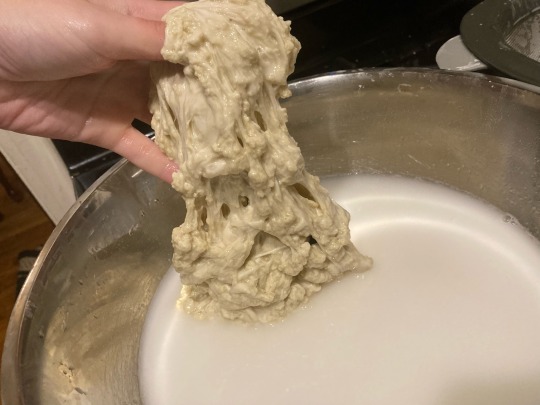
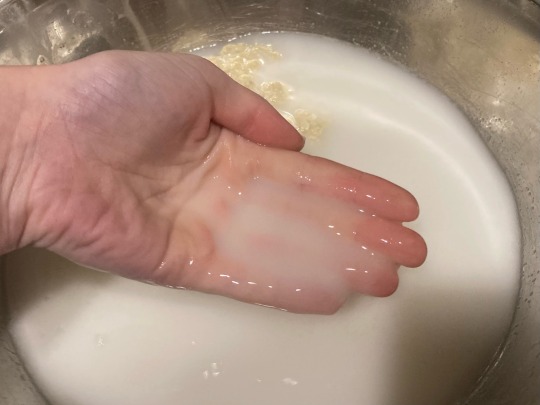
After the fourth wash
7. Drain the dough. Drain the seitan again and allow it to continue draining, flipping over once, until it is noticeably less wet. Squeeze the dough to remove any extra water or starch on the surface.
You now have your washed flour! This will be the base for the rest of the recipe. I had 455g of dough at this point.
To finish the dough:
1. Add all dry ingredients to the dough and knead again to distribute evenly; or use a blender for about 30 seconds until everything is well-incorporated and the gluten strands are visible.
2. Pull the dough into a single long, thick strand, and then tie it into a couple knots. Do this a few times to build structure.
To cook:
The dough will first be seared to develop a crust, then simmered to infuse it with more flavor. After a rest in the simmering liquid, it is seared again to re-crisp, then tossed in the thickened liquid to form a glaze.
1. Divide dough into four pieces. In a large skillet, heat 2 tsp of margarine and 2 tsp of olive oil (or use all olive oil). Add dough pieces and push flat with a spatula. Fry, turning as needed and intermittently pressing flat with the spatula, until the surface is browned and crispy.
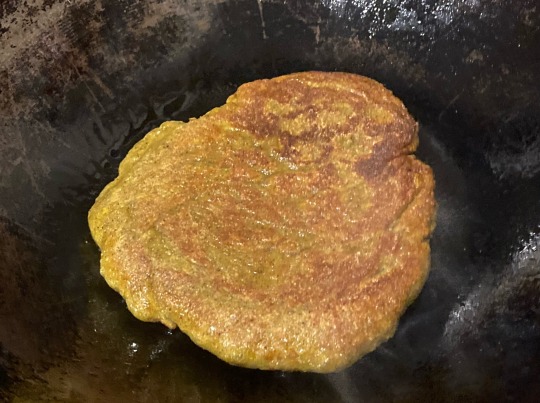
2. Mix liquid simmering ingredients together and whisk to combine. Pour over browned chops and add whole spices and aromatics. If necessary, add more water to cover.
3. Slowly bring simmering liquid up to a bare simmer. Don't let it come to a rolling boil, which could produce a spongey texture.
4. Cook at a very low simmer, uncovered, for 20 minutes, stirring occasionally. Remove from heat and allow to soak in the simmering liquid (including spices and aromatics) for at least an hour in the fridge, or overnight.
This is a good place to stop for the night if you want to make these ahead of time.
5. Remove lamb chops from liquid. In a large pot or deep skillet, bring simmering liquid (including spices and aromatics) to a boil, uncovered, until considerably reduced.
6. Strain to remove whole spices and aromatics. Return to pan and continue to reduce until thickened to a glaze-like consistency.
7. In a clean skillet, fry lamb chops again in remaining margarine and oil until browned and crispy. Add glaze and cook, flipping and agitating occasionally, for a couple minutes until coated.
Serve immediately over rice or frika (فريكة / freekeh), topped with fried pine nuts, alongside plain cultured soy yoghurt, pickles, olives, and a side salad, etc.
144 notes
·
View notes
Text

Vegan Irish "Egg" Rolls
inspired by a dish at the now defunct Clarke’s Irish Pub in Miami Beach, these egg rolls are stuffed with a traditional Irish meal, veganized!
#vegan#lunch#st. patrick's day#veganized#egg rolls#potato#cabbage#seitan#paprika#mustard powder#vegan worcestershire sauce#garlic powder#soy sauce#plant milk#vegan butter#coriander#vegan egg#mustard#black pepper#sea salt#egg roll wrappers
120 notes
·
View notes
Text

I made "meat" out of flour, and I feel a little bit badass about it!
7 notes
·
View notes
Note

Hab grade das hier in unserem Kühlschrank gefunden und musste lachen.
für alle Seitanisten
213 notes
·
View notes
Photo

Now, look, the most interesting thing here is that this beach in the background is called Seitan Limania, which means “Satan’s harbours”.
Photo by marios_bentsos on Instagram.
32 notes
·
View notes
Text

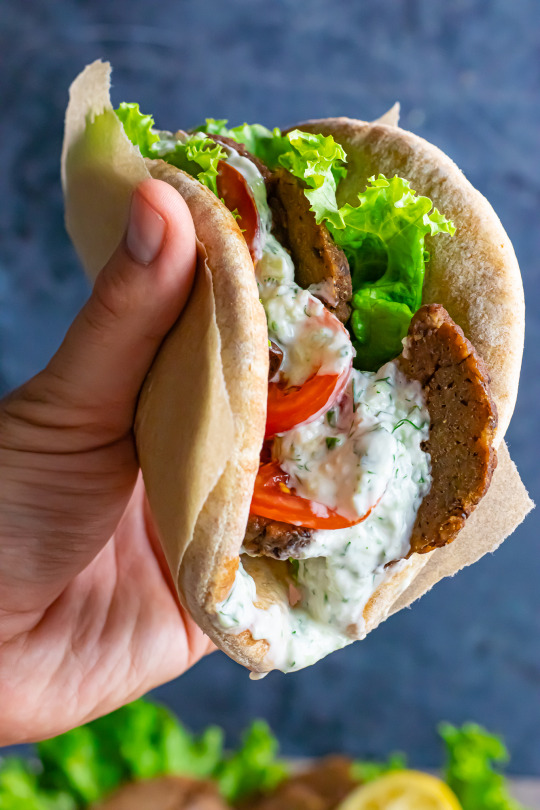
Easy Vegan Seitan Gyros
#vegan#food#vegetarian#vegan food#veganism#recipe#plantbased#vegan recipe#dinner#gyros#seitan#vegan dinner#meatless
22 notes
·
View notes
Text

Homemade Vegan Pepperoni
#pepperoni#savoury#pork#meat#cooking#seitan#food#recipe#recipes#vegan#veganism#vegetarian#plantbased#plant based#foodie#foodporn#baking#foodpics#foodphotography#vegan foodporn#vegan food#vegan recipes#vegan recipe#what vegans eat#veganrecipes#go vegan#home cooking#nut free
16 notes
·
View notes